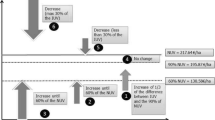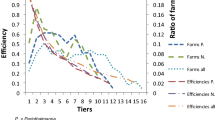Abstract
The present paper analyses both managerial and program efficiencies of Lithuanian family farms, in the tradition of Charnes et al. (Manag Sci 27(6):668–697, 1981) but with the important difference that multi-directional efficiency analysis rather than the traditional data envelopment analysis approach is used to estimate efficiency. This enables a consideration of input-specific efficiencies. The study shows clear differences between the efficiency scores on the different inputs as well as between the farm types of crop, livestock and mixed farms respectively. We furthermore find that crop farms have the highest program efficiency, but the lowest managerial efficiency and that the mixed farms have the lowest program efficiency (yet not the highest managerial efficiency).





Similar content being viewed by others
Notes
An alternative approach would rely on a Malmquist index analysis, which has not yet been defined for MEA and consequently is outside the scope of the current paper.
Note that our study employs these commonly used variables expressed in the real monetary terms rather than physical quantities. This is done in order to ensure that all the variables represent flows rather than stocks. In addition, this allows aggregating inputs which, in turn, enables us to graphically illustrate the underlying isoquants.
It should be noted that there was a steep decrease in the investment goods index between 2009 and 2010, causing an increase in the depreciation expressed in real terms. To check the robustness of the results, we therefore also tried to use only the consumer price index for all the variables within the model. The results turned out to be very similar in structure.
For data on product-mix among Lithuanian family farms, please consult Table 8 in Lithuanian Institute of Agrarian Economics (2012).
As pointed out by a reviewer, an alternative test for comparing DEA-based efficiency scores is provided by Simar and Zelenyuk (2006) based on the test of Li (1996, 1999). Applying Algorithm 1 from Simar and Zelenyuk (2006) with 1000 bootstrap replications was, however, not useful in practice given the size of our data set with over 10,000 observations, since the calculations for a single equality test took more than 24 h on an Intel Core i5 3.2 GHz with 4 Gb RAM.
One might expect an increase in efficiency once the adjustments required by certain support measures are fully met by the farmers.
For instance, the smallest farms (<10 ha) received 0.74 Lt per liter of milk, whereas the largest ones (over 150 ha) received 1.08 Lt per liter in 2011. For these data, please see Table 5 in Lithuanian Institute of Agrarian Economics (2012).
References
Asmild M, Matthews K (2012) Multi-directional efficiency analysis of efficiency patterns in Chinese Banks 1997–2008. Eur J Oper Res 219:434–441
Asmild M, Hougaard JL, Kronborg D, Kvist HK (2003) Measuring inefficiency via potential improvements. J Prod Anal 19(1):59–76
Banker RD, Charnes A, Cooper WW (1984) Some models for estimating technical and scale inefficiencies in data envelopment analysis. Manag Sci 30(9):1078–1092
Beltrán-Esteve M, Reig-Martínez E (2014) Comparing conventional and organic citrus grower efficiency in Spain. Agric Syst 129:115–123
Bogetoft P, Hougaard JL (1999) Efficiency evaluations based on potential (non-proportional) improvements. J Prod Anal 12:233–247
Bojnec S, Latruffe L (2008) Measures of farm business efficiency. Ind Manag Data Syst 108(2):258–270
Bojnec S, Latruffe L (2011) Farm size and efficiency during transition: insights from Slovenian Farms. Trans Bus Econ 10(3):104–116
Charnes A, Cooper WW, Rhodes E (1978) Measuring the efficiency of decision making units. Eur J Oper Res 2(6):429–444
Charnes A, Cooper WW, Rhodes E (1981) Evaluating program and managerial efficiency: an application of data envelopment analysis to program follow through. Manag Sci 27(6):668–697
Dios-Palomares R, Martínez-Paz JM (2012) Technical, quality and environmental efficiency of the olive oil industry. Food Policy 36(4):526–534
Eurostat (2008) Handbook for EU agricultural price statistics, Version 2.0. http://ec.europa.eu/eurostat/ramon/statmanuals/files/Handbook%20for%20EU%20Agricultural%20Price%20Statistics%202008.pdf
Eurostat (2014) Annual National Accounts database. http://epp.eurostat.ec.europa.eu/portal/page/portal/national_accounts/data/database
FADN (2010) Farm accounting data network: an A to Z of methodology. http://ec.europa.eu/agriculture/rica/pdf/site_en.pdf
Farrell MJ (1957) The measurement of technical efficiency. J Roy Stat Soc Series A Gen 120(3):253–281
Gómez-Limón JA, Picazo-Tadeo AJ, Reig-Martínez E (2012) Eco-efficiency assessment of olive farms in Andalusia. Land Use Policy 29(2):395–406
Gorton M, Davidova S (2004) Farm productivity and efficiency in the CEE applicant countries: a synthesis of results. Agric Econ 30:1–16
Holvad T, Hougaard JL, Kronborg D, Kvist HK (2004) Measuring Inefficiency in the Norwegian Bus industry using multi-directional efficiency analysis. Transportation 31(3):349–369
Hougaard JL, Kronborg D, Overgård C (2004) Improvement potential in Danish elderly care. Health Care Manag Sci 7(3):225–235
Latruffe L, Balcombe K, Davidova S, Zawalinska K (2005) Technical and scale efficiency of crop and livestock farms in Poland: Does specialization matter? Agric Econ 32(3):281–296
Li Q (1996) Nonparametric testing of closeness between two unknown distribution functions. Econom Rev 15:261–274
Li Q (1999) Nonparametric testing of the similarity of two unknown density functions: local power and bootstrap analysis. J Nonparametr Stat 11:189–213
Lithuanian Institute of Agrarian Economics (2012) Ūkių veiklos rezultatai (ŪADT tyrimo duomenys) 2011 [FADN survey results 2011]. Lietuvos agrarinės ekonomikos institutas, Vilnius. ISSN 2029-1221
Liu JS, Lu LYY, Lu WM, Lin BJY (2013) Data envelopment analysis 1978–2010: a citation-based literature survey. Omega 41:3–15
Mancebón MJ, Calero J, Choi Á, Ximénez-de-Embún DP (2012) The efficiency of public and publicly subsidized high schools in Spain: evidence from PISA-2006. J Oper Res Soc 63:1516–1533
Minviel JJ, Latruffe L (2014) Meta-regression analysis of the impact of agricultural subsidies on farm technical efficiency. Paper prepared for presentation at the EAAE 2014 Congress ‘Agri-Food and Rural Innovations for Healthier Societies’, August 26 to 29, 2014, Ljubljana, Slovenia
Simar L, Zelenyuk V (2006) On testing equality of distributions of technical efficiency scores. Econom Rev 25(4):497–522
Statistics Lithuania, 2012. Agriculture in Lithuania 2011. Vilnius
Wollni M, Brümmer B (2012) Productive efficiency of specialty and conventional coffee farmers in Costa Rica: accounting for technological heterogeneity and self-selection. Food Policy 37(1):67–76
Author information
Authors and Affiliations
Corresponding author
Rights and permissions
About this article
Cite this article
Asmild, M., Baležentis, T. & Hougaard, J.L. Multi-directional program efficiency: the case of Lithuanian family farms. J Prod Anal 45, 23–33 (2016). https://doi.org/10.1007/s11123-014-0419-6
Published:
Issue Date:
DOI: https://doi.org/10.1007/s11123-014-0419-6
Keywords
- Multi-directional efficiency analysis (MEA)
- Managerial efficiency
- Program efficiency
- Data envelopment analysis (DEA)
- Family farms
- Lithuania




